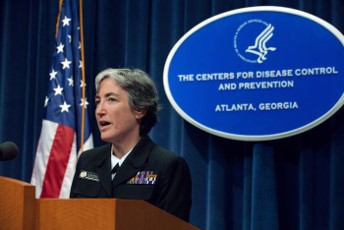Flu Fighter Dr. Anne Schuchat, MD (RADM, USPHS)
Principal Deputy Director of CDC, Dr. Anne Schuchat, is one of the many veterans of CDC’s fight on flu. Combatting influenza is a hallmark of Dr. Schuchat’s 30 years at CDC. In reflecting on the 1918 influenza pandemic, Dr. Schuchat says studying what happened can help us to better prepare the nation and the world for similar scenarios in the future.
Why the 1918 Pandemic Still Matters
When a new influenza virus swept the globe in 2009, Dr. Anne Schuchat was part of the leadership team that guided CDC’s 2009 H1N1 influenza pandemic response, often acting as the face of CDC, explaining developments in her typical reassuring and professional style. As a physician and seasoned epidemiologist, Dr. Schuchat who was at the time director of CDC’s National Center for Immunization and Respiratory Diseases was uniquely qualified to serve as chief health officer and a high-profile spokesperson for CDC’s 2009 pandemic response. Now Principal Deputy Director of CDC, Dr. Schuchat is one of the agency’s many flu fighter veterans reflecting back on the 2009 pandemic, as well as the shockingly severe pandemic of 1918 that decimated entire communities and took an estimated 675,000 American lives.
“It (1918) was a terrible year for flu. It was a very severe pandemic, and by studying what happened, we can then try to better prepare the nation and the world for similar scenarios in the future,” Dr. Schuchat says.
Being a Flu Fighter
Combatting influenza is one of the hallmarks of Dr. Schuchat’s 30 years at CDC. She emphasizes the challenges of preparing for and responding to flu, a constantly changing virus, noting that every year is different. “CDC and its public health approaches hopefully improve every year, but there are surprises and challenges with this virus and with running a full-scale public health response that are extremely tough,” she notes.
CDC maintains a significant presence in fighting influenza both in the U.S. and around the world. As one of six international collaborating centers within the World Health Organization, the agency plays an essential role in global surveillance of influenza, she says.
CDC has programs in more than 50 countries to strengthen its ability to detect and respond to influenza. “We use this global network to get a better idea of the seasonal viruses that are circulating in people every year, as well as those rare clusters of human infections with influenza viruses that may emerge from birds, pigs or other species. These emerging viruses are an important part of what we are looking for when we monitor for viruses that possess potential for causing a pandemic,” Dr. Schuchat explains.
Planning and Preparation are Critical; Challenges Remain
The 2009 pandemic taught us to expect the unexpected, Dr. Schuchat says.
“A key difference in our preparedness right now is that we explicitly plan for uncertainty. We always knew a pandemic would not follow the playbook and that we would need to be ready for something different, but I think right now we’re even more mindful of that,” she says.
Since 2009, there have been improvements in surveillance for detecting new flu viruses and in vaccine development, she continues. Preparedness efforts continue to advance as well, with CDC training extensively for the unexpected with public health systems in the U.S. and around the world.
A future pandemic is inevitable, Dr. Schuchat says, and a reminder that we must stay vigilant and prepared. “As we remember 1918, I know we’re not as prepared as we need to be, and we need to continue to focus on protecting the population and mitigating the harm that a pandemic can have.”



